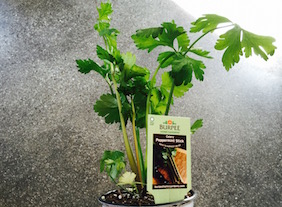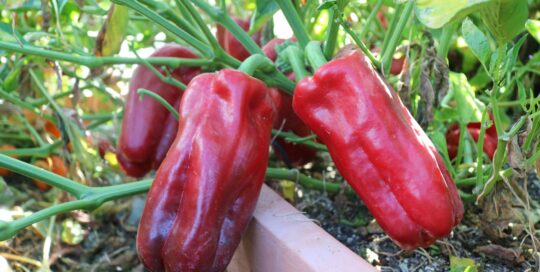New Peppermint Stick Celery from Burpee Home Gardens
Views: 8167

As an adventurous vegetable gardener, I enjoy trying to grow at least one new vegetable each year. Last year it was brussels sprouts. Fabulous! Another year was kohlrabi. I had less spectacular results with that one. And about five years ago or so it was celery. Results? It was a mixed bag. More on that later. But I haven’t grown it since. Not for a lack of interest, but because I haven’t really seen the small plants in the garden center when I’ve been making my springtime purchases. I have no excuses this year, because there is a pot of celery sitting in my office as I type. The folks at Burpee Home Gardens have sent me a box of sample plants of new varieties, and in it was one pot of their new variety called Peppermint Stick Celery.
What is Peppermint Stick Celery?
I’ve seen this full-grown plant in person recently, and I can tell you that it is not red-and-white striped like a peppermint stick. Nor is it minty. Rather, the celery ribs are gently streaked with red stripes. Those ribs, by the way, are thinner than the commercially grown celery you find in your local mega mart. Burpee Home Gardens also claims the celery ribs are intensely flavored of celery. I’m assuming the same is true of its leaves. If you’ve never used celery leaves, you’re missing a treat. Give them a light chop and sprinkle on a salad or top dish as you would with parsley. Another thing the folks at Burpee Home Gardens say about Peppermint Stick Celery is that this variety is slow to bolt. That is, it won’t suddenly grow a reproductive stalk and get set to flower (and hence stop growing) during hot spells. Good news for you warm-region gardeners.
Dealing with Septoria Leaf Blight in celery
Now, back to why I haven’t rushed out to purchase and grow celery since my first growing experience. My plants contracted the Septoria Leaf Blight, which shows itself as bronze to black spotting on leaves and ribs. It’s easily transmittable via watering and splashing of spore-ridden droplets. It appears it often comes from infected seed. The cure? Not sure there is one.
It’s been a while since I’ve had that infected celery in my plot, but just in case these septoria spores are still around, I am planting this Peppermint Stick Celery in my second garden where I know celery hasn’t been planted in several years. My other option is to plant this celery in a mixed herb container or mixed flower container. Hey, why not? It’s tall and has great foliage, so would really thrive in a combination.
Peppermint Stick needs full sun, so off it goes to my full-sun garden. I’ll keep you updated on how this new celery variety performs for me.
Meet Ellen Wells
When you’re raised on a farm, you can’t help but know a thing or two about gardening. Ellen Wells is our expert on edible gardening.…
Ellen's Recent Posts

Pepper Red Impact an All-America Selections Winner






